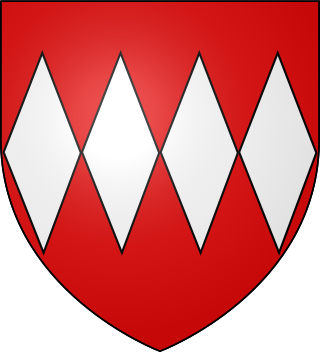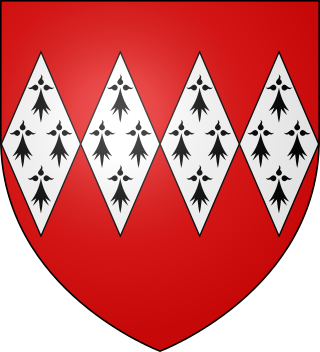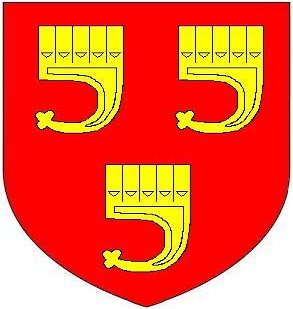
Thomas Herbert, 8th Earl of Pembroke and 5th Earl of Montgomery,, styled The Honourable Thomas Herbert until 1683, was an English and later British statesman during the reigns of William III and Anne.

Baron Talbot of Malahide is a title that has been created twice for members of the same family—in 1831 in the Peerage of Ireland as Baron Talbot of Malahide, and in 1856 in the Peerage of the United Kingdom as Baron Talbot de Malahide. While the barony of 1856 became extinct in 1973, the barony of 1831 is extant. The ancestral seat of the family until 1976 was Malahide Castle, close to the village of that name, north of Dublin, Ireland.

Trerice is an historic manor in the parish of Newlyn East, near Newquay, Cornwall, United Kingdom. The surviving Tudor manor house known as Trerice House is located at Kestle Mill, three miles east of Newquay. The house with its surrounding garden has been owned by the National Trust since 1953 and is open to the public. The house is a Grade I listed building. The two stone lions on the front lawn are separately listed, Grade II. The garden features an orchard with old varieties of fruit trees.

John Arundell, Esquire, of Trerice in Cornwall, later given the epithet "Jack for the King", was a member of an ancient Cornish gentry family, who as a Royalist during the Civil War served King Charles I as Governor of Pendennis Castle, Falmouth. In 1646 he retained the castle in a heroic manner during a five-month-long siege by Fairfax, during which his forces were reduced by hunger to eating their horses, and finally achieved an honourable surrender

Sir John Arundell (1495–1561), of Trerice, Cornwall, nicknamed "Tilbury Jack", was a commander of the Royal Navy during the reigns of Kings Henry VIII and Edward VI and served twice as Sheriff of Cornwall.

John Arundell, of Trerice in Cornwall, was a Member of Parliament for Mitchell, Cornwall, in 1555 and 1558, and was High Sheriff of Cornwall in 1573–1574.

Henry Daubeney – also known as, Dabney, 1st Earl of Bridgewater and 2nd Baron Daubeney was an English peer who sat in the House of Lords.

Mary Arundell, Countess of Arundel, was an English courtier. She was the only child of Sir John Arundell of Lanherne, Cornwall, by his second wife, Katherine Grenville. She was a gentlewoman at court in the reign of King Henry VIII, serving two of Henry VIII's Queens, and the King's daughter, Princess Mary. She was traditionally believed to have been "the erudite Mary Arundell", the supposed translator of verses now known to have been the work of her stepdaughter, Mary FitzAlan, later the first wife of Thomas Howard, 4th Duke of Norfolk.

John Arundell, 2nd Baron Arundell of Trerice of Trerice, Cornwall, was an English politician who sat in the House of Commons at various times between 1666 and 1687 when he inherited his peerage.

Sir Thomas Grenville II, K.B.,, lord of the manors of Stowe in Kilkhampton, Cornwall and Bideford, Devon, Sheriff of Cornwall in 1481 and 1486. During the Wars of the Roses, he was a Lancastrian supporter who had taken part in the conspiracy against Richard III, organised by the Duke of Buckingham. On the accession of King Henry VII (1485–1509) to the throne, Sir Thomas was appointed one of the Esquires of the Body to Henry VII. On 14 November 1501 upon the marriage of Prince Arthur to Katherine of Aragon, he was created a Knight of the Bath. He served on the Commission of the Peace for Devon from 1510 to his death in circa 1513.

Sir John Dinham (1406–1458) was a knight from Devonshire, England. His principal seats were at Nutwell and Kingskerswell in South Devon and Hartland in North Devon.

The manor of Bideford in North Devon was held by the Grenville family between the 12th and 18th centuries. The full descent is as follows:

Sir John Arundell VII (1421–1473) of Lanherne in the parish of St Mawgan in Pydar, Cornwall, was Sheriff of Cornwall and Admiral of Cornwall, and served as a general for King Henry VI in his French wars. He became the largest free tenant in Cornwall.

Sir John Arundell, called The Magnificent, of Lanherne in the parish of St Mawgan in Pydar in Cornwall, was an English knight who inherited large estates in the County of Cornwall. He was Sheriff of Cornwall and was one of Henry IV of England’s Kings Knights. In his will dated 1433, he bequeathed money for the preservation of the head of St Piran in the chapel at Perranzabuloe.

The Arundell family of Cornwall are a Cornish family of Norman origin.

John Arundell, 3rd Baron Arundell of Trerice of Trerice, Cornwall, who inherited his peerage on the death of his father in 1698.

John Arundell, 4th Baron Arundell (1701-1768) of Trerice, Cornwall, inherited his peerage on the death of his father in 1706. He was the last Baron Arundel of Trerice since he had no heir upon his death and the title ultimately passed to Sir Thomas Dyke Acland.

Hayne in the parish of Stowford in Devon, is an historic manor, about 11 miles (18 km) south-west of Okehampton. The surviving manor house, a Grade II* listed building known as Hayne House, was rebuilt in about 1810 by Isaac Donnithorne, who later adopted the surname Harris having married the heiress of Harris of Hayne.

Baron Arcedekne was a peerage created in 1321 for Thomas Arcedekne, 1st Baron Arcedekne (d.1331) of Ruan Lanihorne Castle in Cornwall, Governor of Tintagel Castle in 1312 and Sheriff of Cornwall 1313–14, who was summoned by writ to Parliament in 1321, whereby he became Baron Arcedekne. His descendants were never again summoned to Parliament in respect of the barony, and The Complete Peerage does not list them as holders of that peerage and considers the barony to be abeyant. His descendants were:

The manor of Haccombe was a historic manor in the small parish of Haccombe, near the town of Newton Abbot, Devon, England. It was the seat of important branches of the Courtenay and Carew families.













